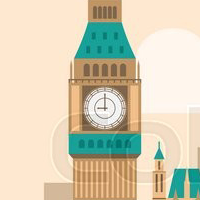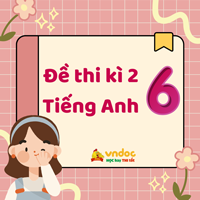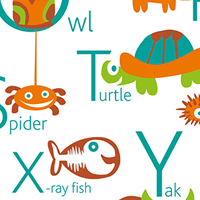Đề thi thử THPT Quốc gia năm 2017 môn Tiếng Anh có đáp án + giải thích chi tiết (Đề 5)
Trắc nghiệm Tiếng Anh THPT Quốc gia 2017
Bạn đã chuẩn bị đầy đủ tài liệu cho kỳ thi TN THPT QG & ĐHCĐ sắp tới chưa? VnDoc. com sẽ giúp bạn có Đề thi thử THPT Quốc gia năm 2017 môn Tiếng Anh có đáp án + giải thích chi tiết được tuyển chọn từ các trường có tiếng trong cả nước. Chúng tôi hi vọng, bộ đề thi thử này sẽ giúp cho việc ôn tập của bạn tốt hơn.
Đề thi thử THPT Quốc gia năm 2017 môn Tiếng Anh có đáp án + giải thích chi tiết (Đề 1)
Đề thi thử THPT Quốc gia năm 2017 môn Tiếng Anh có đáp án + giải thích chi tiết (Đề 3)
Read the following passage and mark the letter A, B, C or D on your answer sheet to indicate the correct word for each of the blanks.
Any change in one part of an ecosystem can cause changes in other parts. Droughts, storms and fires can change ecosystems. Some changes (1) _________ ecosystems. If there is too (2) _________ rainfall, plants will not have enough water to live. If a kind of plant dies off, the animals that feed on it may also die or move away. Some changes are good for ecosystems. Some pine forests need fires for the pine trees to reproduce. The seeds are sealed inside pinecones. Heat from a forest fire melts the seal and lets the seeds (3) _________. Polluting the air, soil, and water can harm ecosysterms. Building (4)_________ on rivers for electric power and irrigation can harm ecosystems around the rivers. Bulldozing wetlands and cutting down forests destroy ecosystems. Ecologists are working with companies and governments to find better ways of (5) _________ fish, cutting down trees, and building dams. They are looking for ways to get food, lumber, and other products for people without causing harm to ecosystems.
Question 1. A. harms B. harmful C. harmless D. harm
Question 2. A. little B. a little C. few D. a few
Question 3. A. out B. in C. go D. fly
Question 4. A. moats B. ditches C. bridges D. dams
Question 5. A. catching B. holding C. carrying D. taking
Mark the letter A, B, c, or D on your answer sheet to indicate the word whose underlined part that differs from the other three in the pronunciation in each of the following questions.
Question 6: A. state B. status C. station D. statue
Question 7: A. bury B. carry C. heavy D. many
Mark the letter A, B, C, or D on your answer sheet to indicate the word that differs from the rest in the position of the main stress in each of the following questions.
Question 8: A. popularity B. conscientious C. apprenticeship D. personality
Question 9: A. consonant B. divisible C. significant D. mosquito
Read the following passage and mark the letter A, B, C or Don your answer sheet to indicate the correct answer
In the last third of the nineteenth century a new housing form was quietly being developed. In 1869 the Stuyvesant, considered New York's first apartment house was built on East Eighteenth Street. The building was financed by the developer Rutherfurd Stuyvesant and designed by Richard Morris Hunt, the first American architect to graduate from the Ecole des Beaux Arts in Paris. Each man had lived in Paris, and each understood the economics and social potential of this Parisian housing form. But the Stuyvesant was at best a limited success. In spite of Hunt's inviting facade, the living space was awkwardly arranged. Those who could afford them were quite content to remain in the more sumptuous, single-family homes, leaving the Stuyvesant to newly married couples and bachelors.
The fundamental problem with the Stuyvesant and the other early apartment buildings that quickly followed, in the 1870's and early 1880's was that they were confined to the typical New York building lot. That lot was a rectangular area 25 feet wide by 100 feet deep-a shape perfectly suited for a row house. The lot could also accommodate a rectangular tenement, though it could not yield the square, well-lighted, and logically arranged rooms that great apartment buildings require. But even with the awkward interior configurations of the early apartment buildings, the idea caught on. It met the needs of a large and growing population that wanted something better than tenements but could not afford or did not want row houses.
So while the city's newly emerging social leadership commissioned their mansions, apartment houses and hotels began to sprout in multiple lots, thus breaking the initial space constraints. In the closing decades of the
Question 10: The new housing form discussed in the passage refers to
A. single-family homes B. apartment buildings C. row houses D. hotels
Question 11: The word "inviting" in bold is closest in meaning to
A. open B. encouraging C. attractive D. asking
Question 12: Why was the Stuyvesant a limited success?
A. The arrangement of the rooms was not convenient.
B. Most people could not afford to live there,
C. There were no shopping areas nearby.
D. It was in a crowded neighborhood.
Question 13: It can be inferred that the majority of people who lived in New York's first apartments were
A. highly educated B. unemployed C. wealthy D. young
Question 14: It can be inferred that a New York apartment building in the 1870's and 1880's had all of the following characteristics EXCEPT:
A. Its room arrangement was not logical. B. It was rectangular,
C. It was spacious inside. D. It had limited light.
Question 15: The word "yield" in bold is closest in meaning to
A. harvest B. surrender C. amount D. provide
Question 16: Why did the idea of living in an apartment become popular in the late 1800's?
A. Large families needed housing with sufficient space.
B. Apartments were preferable to tenements and cheaper than row houses
C. The city officials of New York wanted housing that was centrally located.
D. The shape of early apartments could accommodate a variety of interior designs.
Question 17: The author mentions the Dakota and the Ansonia in bold because
A. they are examples of large, well-designed apartment buildings
B. their design is similar to that of row houses
C. they were built on a single building lot
D. they are famous hotels
Mark the letter A, B, C, or D to indicate the word or phrase that is OPPOSITE in meaning to the italic part in each of the following questions
Question 18: Mr. Smith's new neighbors appear to be very friendlỵ.
A. amicable B. inapplicable C. hostile D. futile
Question 19: The clubs meet on the last Thursday of every month in a dilapidated palace.
A. renovated B. regenerated C. furnished D. neglected
Mark the letter A, B, C, or D on your answer sheet to indicate the correct answer to each of the following questions.
Question 26: For lunch, I always have something quick and easy: a sandwich, a salad, toast and the ________.
A. same B. similar C. like D. rest
Question 27: 1 don't think anyone understood what I was saying at the meeting, did they? I totally failed to get my point ________.
A. around B. along C. across D. about
Question 28: This fruit has been in the fridge for over three weeks! It is all.
A. sour B. mouldy C. rotten D. bitter
Question 29: As I have just had a tooth, I am not allowed to eat or drink anything for three hours.
A. Taken out B. crossed out C. broken off D. tried on
Question 30: We don't seem to have any more of that book, Sir. It is out of but we are getting a new delivery next Thursday if you would like to pop back then.
A. stock B. order C. print D. shop
Question 31: - "What do you think of football?" - "_______________"
A. I am crazy about it. B. Of course, football players are excellent
C. Well, it's beyond my expectation D. It's none of my business.










